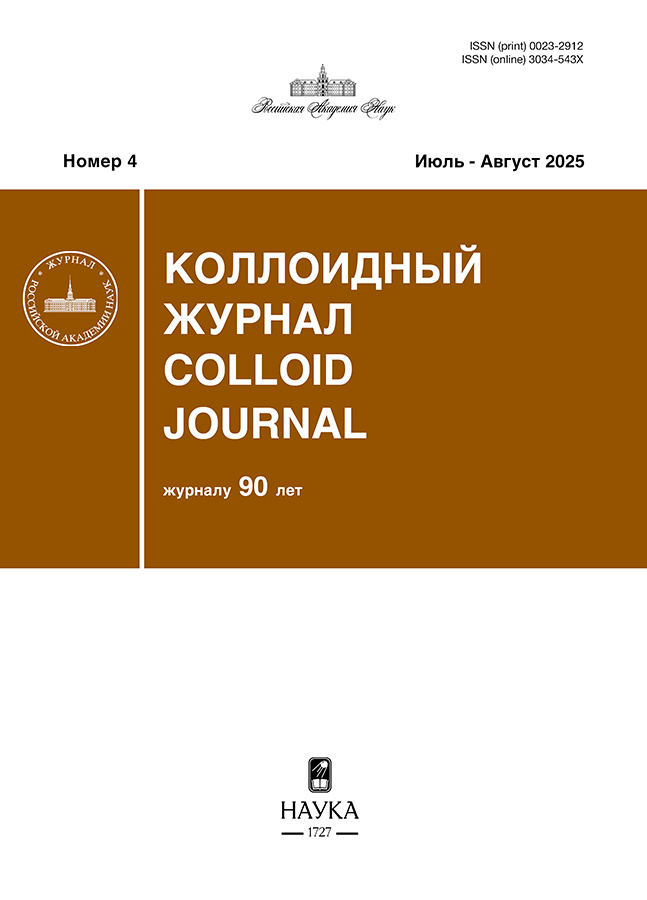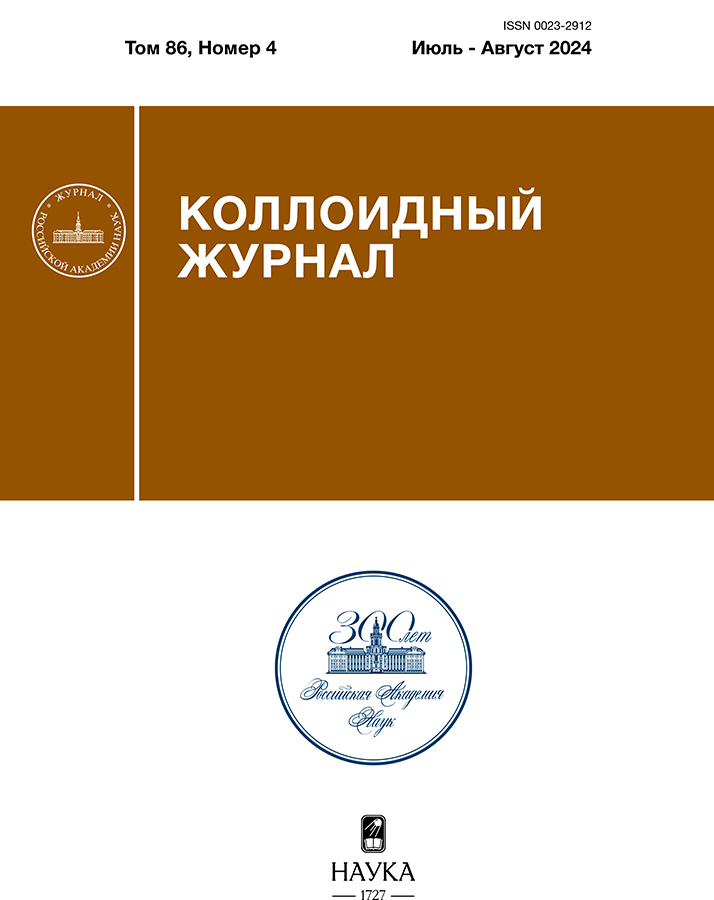Структурообразование неионогенного блоксополимера pluronic P123 при варьировании температуры
- Авторы: Завалюева А.С.1, Карпов С.И.1, Дубовицкая А.Н.1, Холявка М.Г.1, Селеменев В.Ф.1
-
Учреждения:
- Воронежский государственный университет
- Выпуск: Том 86, № 4 (2024)
- Страницы: 446-457
- Раздел: Статьи
- Статья получена: 27.02.2025
- Статья опубликована: 21.10.2024
- URL: https://cijournal.ru/0023-2912/article/view/670862
- DOI: https://doi.org/10.31857/S0023291224040042
- EDN: https://elibrary.ru/capcyh
- ID: 670862
Цитировать
Полный текст
Аннотация
Методом динамического рассеяния света исследованы водные растворы Pluronic P123 при варьировании температуры, растворителя и добавок кверцетина. Выявлены существенные изменения среднего размера частиц и индекса полидисперсности в зависимости от условий. Изучено влияние температуры на мицеллообразование блоксополимера в водном растворе в интервале T = 15–45°С, наиболее часто рассматриваемом при использовании Р123 в золь-гель синтезе кремнеземов. Наиболее существенное влияние температуры на мицеллообразование рассматриваемого ПАВ отмечено при T = 15–20°C. При этом распределение интенсивности рассеяния по размерам полимодально, что указывает на присутствие в системе макромолекул, мицелл и их агрегатов. Дальнейший рост температуры до 45°C не приводит к значительному изменению размера частиц. В водных растворах в интервалах температур 21–25 и 35–40°C формируются мицеллы с узким распределением по размерам (минимальным индексом полидисперсности). Отмечено значительное влияние добавок алканолов и полифенольных веществ как солюбилизатов, способных влиять на структуру мицелл как в их объеме, так и на поверхности полярных частей ПАВ. Показано, что в присутствии бутанола-1 наблюдается стабилизация мицелл при температурах 15–20°C. При T > 30°C происходят перестройки структуры мицелл. По мере увеличения доли бутанола-1 в растворе его влияние проявляется при меньших температурах. Отмечено, что этанол оказывает деструктивное действие на мицеллы. Добавки кверцетина проявляют противоположный стабилизирующий мицеллы эффект, приводящий к формированию однородной структуры ПАВ. Показано, что, варьируя состав растворителя, можно контролировать связывание флавоноида с мицеллой за счет изменения сольватации. Наибольшее влияние кверцетина на структурообразование P123 отмечено при составе растворителя, отвечающего мольному соотношению этанола и блоксополимера n(EtOH) : n(P123)=80 : 1.
Ключевые слова
Полный текст
Об авторах
А. С. Завалюева
Воронежский государственный университет
Автор, ответственный за переписку.
Email: a-kh-01@yandex.ru
Россия, Университетская пл., 1, Воронеж, 394018
С. И. Карпов
Воронежский государственный университет
Email: a-kh-01@yandex.ru
Россия, Университетская пл., 1, Воронеж, 394018
А. Н. Дубовицкая
Воронежский государственный университет
Email: a-kh-01@yandex.ru
Россия, Университетская пл., 1, Воронеж, 394018
М. Г. Холявка
Воронежский государственный университет
Email: a-kh-01@yandex.ru
Россия, Университетская пл., 1, Воронеж, 394018
В. Ф. Селеменев
Воронежский государственный университет
Email: a-kh-01@yandex.ru
Россия, Университетская пл., 1, Воронеж, 394018
Список литературы
- Patidar P., Bahadur A. Modulating effect of different biomolecules and other additives on cloud point and aggregation of amphiphilic linear and starblock copolymer // Journal of Molecular Liquids. 2018. V. 249. P. 219–226. https://doi.org/10.1016/j.molliq.2017.11.019
- Patidar P., Pillai S.A., Bahadur P., Bahadur A. Tuning the self-assembly of EO-PO block copolymers and quercetin solubilization in the presence of some common pharmacuetical excipients: A comparative study on a linear triblock and a starblock copolymer // Journal of Molecular Liquids. 2017. V. 241. P. 511–519. https://doi.org/10.1016/j.molliq.2017.06.035
- Wei D., Ge L., Guo R. Microstructure transition of hydrophilic modified ibuprofen and Pluronic copolymer F127 complexes // Colloid and Polymer Science. 2013. V. 291. P. 1255–1265. https://doi.org/10.1007/s00396-012-2859-8
- Basak R., Bandyopadhyay R. Encapsulation of hydrophobic drugs in Pluronic F127 micelles: Effects of drug hydrophobicity, solution temperature, and pH // Langmuir. 2013. V. 29. № 13. P. 4350–4356. https://doi.org/10.1021/la304836e
- Zhao D., Feng J., Huo Q. et al. Triblock copolymer syntheses of mesoporous silica with periodic 50 to 300 angstrom pores // Science. 1998. V. 279. № 5350. P. 548–552. https://doi.org/10.1126/science.279.5350.548
- Kim T. W., Kleitz F., Paul B., Ryoo R. MCM-48-like large mesoporous silicas with tailored pore structure: Facile synthesis domain in a ternary triblock copolymer-butanol-water system // Journal of the American Chemical Society. 2005. V. 127. № 20. P. 7601–7610. https://doi.org/10.1021/ja042601m
- Roik N.V., Belyakova L.A., Dziazko M.O., Oranska O.I. Influence of azo dye additives on structural ordering of mesoporous silicas // Applied Nanoscience. 2020. V. 10. № 8. P. 2547–2556. https://doi.org/10.1007/s13204-019-01013-5
- Дементьева О.В., Наумова К.А., Шишмакова Е.М. и др. Синтез бифункциональных частиц-контейнеров из кремнезема на мицеллах антисептика с солюбилизированным куркумином и оценка их биологической активности // Коллоид. журн. 2021. Т. 83. № 6. С. 623–633. https://doi.org/10.31857/s0023291221060021
- Beck J.S., Vartuli J.C., Roth W.J. et al. A new family of mesoporous molecular sieves prepared with liquid crystal templates // Journal of the American Chemical Society. 1992. V. 114. № 27. P. 10834–10843. https://doi.org/10.1021/JA00053A020
- Wanka G., Hoffmann H., Ulbricht W. Phase diagrams and aggregation behavior of poly(oxyethylene)-poly(oxypropylene)-poly(oxyethylene) triblock copolymers in aqueous solutions // Macromolecules. 1994. V. 27. № 15. P. 4145–4159. https://doi.org/10.1021/ma00093a016
- Letaief N., Lucas-Girot A., Oudadesse H. et al. Effect of aging temperature on the structure, pore morphology and bioactivity of new sol-gel synthesized bioglass // Journal of Non-Crystalline Solids. 2014. V. 402. P. 194–199. https://doi.org/10.1016/j.jnoncrysol.2014.06.005
- Хлуднева А.С., Карпов С.И., Ресснер Ф., Селеменев В.Ф. Структура и сорбционные свойства мезопористых кремнеземов, синтезированных при варьировании температуры и кремниевой основы // Сорбционные и хроматографические процессы. 2021. Т. 21. № 5. С. 669–680. https://doi.org/10.17308/sorpchrom.2021.21/3773
- Dan H., Chen L., Xian Q. et al. Tailored synthesis of SBA-15 rods using different types of acids and its application in adsorption of uranium // Separation and Purification Technology. 2019. V. 210. P. 491–496. https://doi.org/10.1016/j.seppur.2018.08.039
- Costa F.O., Misael C.G.A., Silva A.M., Sousa B.V. Textural analysis of SBA-15 molecular sieve using ethanol as co-solvent // Adsorption. 2015. V. 21. P. 671–676. https://doi.org/10.1007/s10450-015-9717-1
- Semeykina V., Zharov I. Medium controlled aggregative growth as a key step in mesoporous silica nanoparticle formation // Journal of Colloid and Interface Science. 2022. V. 615. P. 236–247. https://doi.org/10.1016/j.jcis.2022.01.166
- Oliveira M.R., Deon M., Benvenutti E.V. et al. Effect of microwave irradiation on the structural, chemical, and hydrophilicity characteristics of ordered mesoporous silica SBA-15 // Journal of Sol-Gel Science and Technology. 2020. V. 94. P. 708–718. https://doi.org/10.1007/s10971-020-05219-w
- Li Y., Tian Y., Jia X. et al. Effect of pharmaceutical excipients on micellization of Pluronic and the application as drug carrier to reverse MDR // Journal of Molecular Liquids. 2023. V. 383. P. 122182. https://doi.org/10.1016/j.molliq.2023.122182
- Khimani M., Rao U., Bahadur P., Bahadur P. Calorimetric and scattering studies on micellization of Pluronics in aqueous solutions: Effect of the size of hydrophilic PEO end blocks, temperature, and added salt // Journal of Dispersion Science and Technology. 2014. V. 35. № 11. P. 1599–1610. https://doi.org/10.1080/01932691.2013.858349
- Parmar A., Singh K., Bahadur A. et al. Interaction and solubilization of some phenolic antioxidants in Pluronic® micelles // Colloids and Surfaces B: Biointerfaces. 2011. V. 86. № 2. P. 319–326. https://doi.org/10.1016/j.colsurfb.2011.04.015
- Chaghi R., Ménorval L.C.de, Charnay C., Zajac J. Competitive interactions between components in surfactant-cosurfactant-additive systems // Journal of Colloid and Interface Science. 2010. V. 344. № 2. P. 402–409. https://doi.org/10.1016/j.jcis.2009.12.064
- Ерин К.В. Об изменении распределения частиц и агрегатов по размерам при разбавлении магнитных жидкостей // Коллоид. журн. 2017. Т. 79. № 1. С. 32–37. https://doi.org/10.7868/s0023291217010037
- Молодкина Л.М., Голикова Е.В., Бареева Р.С. и др. Кинетика агрегации гидрозоля ОХ50 в растворах NаCl, исследованная методом динамического светорассеяния // Коллоид. журн. 2016. Т. 78. № 5. С. 578–587. https://doi.org/10.7868/s0023291216050104
- Branca C., D’Angelo G. Aggregation behavior of Pluronic F127 solutions in presence of chitosan/clay nanocomposites examined by dynamic light scattering // Journal of Colloid and Interface Science. 2019. V. 542. P. 289–295. https://doi.org/10.1016/j.jcis.2019.02.031
- Luo H., Jiang K., Liang X. et al. Insights into morphological transition of Pluronic P123 micelles as a function of gallate // Colloids and Surfaces A: Physicochemical and Engineering Aspects. 2019. V. 572. P. 221–229. https://doi.org/10.1016/j.colsurfa.2019.04.005
- Dey J., Kumar S., Nath S. et al. Additive induced core and corona specific dehydration and ensuing growth and interaction of Pluronic F127 micelles // Journal of Colloid and Interface Science. 2014. V. 415. P. 95–102. https://doi.org/10.1016/j.jcis.2013.10.019
- Nguyen-Kim V.., Prévost S., Seidel K. et al. Solubilization of active ingredients of different polarity in Pluronic® micellar solutions – Correlations between solubilizate polarity and solubilization site // Journal of Colloid and Interface Science. 2016. V. 477. P. 94–102. https://doi.org/10.1016/j.jcis.2016.05.017
- Parekh P., Dey J., Kumar S. et al. Butanol solubilization in aqueous F127 solution: Investigating the enhanced micellar solvation and consequent improvement in gelation characteristics // Colloids and Surfaces B: Biointerfaces. 2014. V. 114. P. 386–391. https://doi.org/10.1016/j.colsurfb.2013.10.030
- Maheswari U., Sridevi Sangeetha K.S., Umamaheswari S. et al. Flavonoids: Therapeutic potential of natural pharmacological agents // International journal of pharmaceutical sciences and research. 2016. V. 7. № 10. P. 3924–3930. https://doi.org/10.13040/IJPSR.0975-8232.7(10).3924-30
- Taraba A., Szymczyk K., Tyszczuk-Rotko K. Surfactant-rutin-alcohol interactions: A multi-techniques analysis // Journal of Molecular Liquids. 2021. V. 328. P. 115447. https://doi.org/10.1016/j.molliq.2021.115447
- Tiwari S., Ma J., Rathod S., Bahadur P. Solubilization of quercetin in P123 micelles: Scattering and NMR studies // Colloids and Surfaces A: Physicochemical and Engineering Aspects. 2021. V. 621. P. 126555. https://doi.org/10.1016/j.colsurfa.2021.126555
- Roik N.V., Belyakova L.A., Dziazko M.O. Solubilization of azo dyes by cetyltrimethylammonium bromide micelles as structure control factor at synthesis of ordered mesoporous silicas // Journal of Molecular Liquids. 2021. V. 328. P. 115451. https://doi.org/10.1016/j.molliq.2021.115451
- Наумова К.А., Дементьева О.В., Зайцева А.В., Рудой В.М. Солюбилизация как способ создания гибридных мицеллярных темплатов для синтеза многофункциональных мезопористых частиц-контейнеров // Коллоид. журн. 2019. Т. 81. № 4. С. 478–486. https://doi.org/10.1134/s0023291219040098
- H.J., Ryu C.Y. Scalable PEO-PPO-PEO triblock copolymer purification from Pluronics through competitive adsorption // Polymer. 2012. V. 53. № 22. P. 5052–5059. http://doi.org/10.1016/j.polymer.2012.09.009
- Ganguly R., Kumar S., Soumya M. et al. Structural and therapeutic properties of salicylic acid-solubilized Pluronic solutions and hydrogels // Soft Matter. Royal Society of Chemistry. 2024. V. 20. № 9. P. 2075–2086. https://doi.org/10.1039/d4sm00079j
- Filippov S.K., Khusnutdinov R., Murmiliuk A. et al. Dynamic light scattering and transmission electron microscopy in drug delivery: A roadmap for correct characterization of nanoparticles and interpretation of results // Materials Horizons. Royal Society of Chemistry. 2023. V. 10. № 12. P. 5354–5370. https://doi.org/10.1039/d3mh00717k
- Jian T., Anastasiadis S.H., Semenov A.N. et al. Dynamics of composition fluctuations in diblock copolymer solutions far from and near to the ordering transition // Macromolecules. 1994. V. 27. № 17. P. 4762–4773. https://doi.org/10.1021/ma00095a017
- Stepanek P., Lodge T.P. Dynamic Light Scattering from Block Copolymer Melts near the Order-Disorder Transition. 1996. V. 29. № 4. P. 1244–1251. https://doi.org/10.1021/ma9509772
- Ricardo N.M.P.S., Ricardo N.M.P.S., Costa F. de M.L.L. et al. The effect of n-, s- and t-butanol on the micellization and gelation of Pluronic P123 in aqueous solution // Journal of Colloid and Interface Science. 2011. V. 353. № 2. P. 482–489. https://doi.org/10.1016/j.jcis.2010.09.061
- Dahanayake R., Dormidontova E.E. Molecular structure and co-solvent distribution in PPO-PEO and Pluronic micelles // Macromolecules. 2022. V. 55. № 23. P. 10439–10449. https://doi.org/10.1021/acs.macromol.2c01206
- Hsu Y.H., Tsui H.W., Lee C.F. et al. Effect of alcohols on the heat of micellization of Pluronic F88 aqueous solutions // Colloid and Polymer Science. 2015. V. 293. P. 3403–3415. https://doi.org/10.1007/s00396-015-3662-0
- Volkova T., Simonova O., Perlovich G. Revisiting the solubility–permeability relationship with hydrophobic drug umifenovir in Pluronic solutions: Impact of pH and co-solvent // Pharmaceutics. 2023. V. 15. № 2. P. 422. https://doi.org/10.3390/pharmaceutics15020422
- Thapa R.K., Cazzador F., Grønlien K.G., Tønnesen H.H. Effect of curcumin and cosolvents on the micellization of Pluronic F127 in aqueous solution // Colloids and Surfaces B: Biointerfaces. 2020. V. 195. P. 111250. https://doi.org/10.1016/j.colsurfb.2020.111250
- Chaghi R., Ménorval L.C., Charnay C., Zajac J. Competitive interactions between components in surfactant-cosurfactant-additive systems // Journal of Colloid and Interface Science. 2010. V. 344. № 2. P. 402–409. https://doi.org/10.1016/j.jcis.2009.12.064
- Taraba A., Szymczyk K. Spectroscopic studies of the quercetin/rutin-nonionic surfactant interactions // Journal of Molecular Liquids. 2022. V. 360. P. 119483 https://doi.org/10.1016/j.molliq.2022.119483
Дополнительные файлы

















